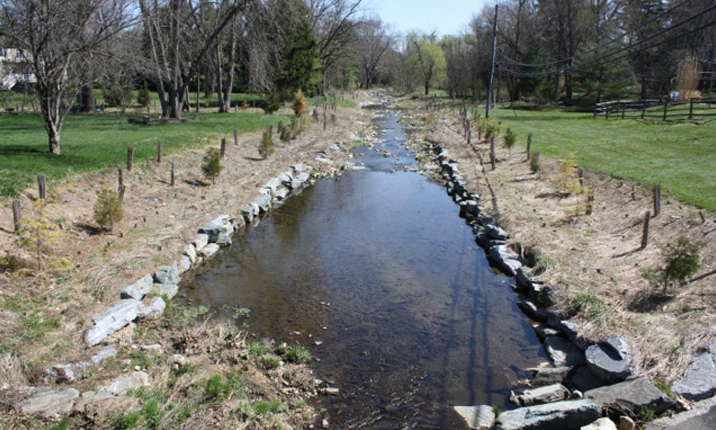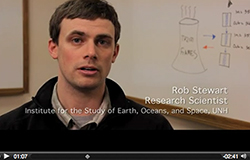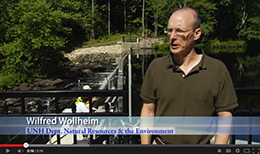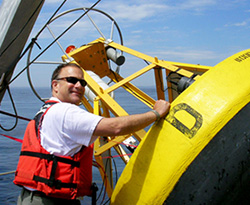
"Evolving" stream in urban ecosystem.

Riverine ecosystem services and the thermoelectric sector: Strategic issues facing the Northeast. [PDF].

EPSCoR Lamprey River Water Study.

NOAA grant lead scientist Joe Salisbury with the UNH CO2 buoy being deployed from the R/V Gulf Challenger.
News Archive
UNH Scientists Find Urban Ecosystems "Evolve"
DURHAM, NH - Cities are generally thought of as highly engineered landscapes that are not as ecologically dynamic as naturally occurring forests and free-flowing streams. But in a series of studies published Sep 10 in a special issue of the journal Biogeochemistry, scientists specializing in urban ecosystems, including two from UNH, show urban and suburban environments are dynamic biological, chemical, and even geological ecosystems that can change relatively quickly in response to human activities. [Read more here.]
Claire Treat and Steve Frolking published a News and Views piece in the October 2013 issue of Nature Climate Change on the fate of carbon stored in Arctic permafrost under changing climate conditions. [Read more here.]
Study finds that Northeast rivers act as horizontal cooling towers
DURHAM, NH - Running two computer models in tandem, scientists from the University of New Hampshire have detailed for the first time how thermoelectric power plants interact with climate, hydrology, and aquatic ecosystems throughout the northeastern U.S. and show how rivers serve as "horizontal cooling towers" that provide an important ecosystem service to the regional electricity sector; but at a cost to the environment. [Read more here.]
NH EPSCoR researchers are studying the environment in an effort to support better management of the state's natural resources, so that population growth and development proceed in a sustainable fashion, without threatening the quality of life that makes New Hampshire a desirable place to live and visit. [Video available here.]
Composing an Aquatic Symphony
DURHAM, NH - In a memorable scene from the movie "Amadeus," Emperor Joseph II tells an incredulous Wolfgang Amadeus Mozart that although the young composer's symphony he'd just premiered was indeed ingenious, it simply had too many notes to digest in one sitting. On the contrary, scientist Wil Wollheim is hoping a current NOAA/NH Sea Grant-funded project he is heading will provide a rare cascade of "notes" to allow composition of what he calls an "aquatic symphony." Such a score would be rich in scientific detail and provide unprecedented insight into the chemical and physical processes of stream and river networks. [Read more here.]
Excess Nutrients Collapsing East Coast Salt Marshes
DURHAM, NH - In a paper published in the Oct 2012 issue of the journal Nature, scientists explain why salt marshes have been disintegrating over the past two decades along the US Eastern seaboard and other highly developed coastlines. Unexpectedly, they discovered that nutrients such as nitrogen and phosphorus from septic and sewer systems and lawn fertilizers can cause salt marsh loss. The researchers, including aquatic ecosystem ecologist Wilfred Wollheim of the University of New Hampshire, based their findings on a long-term, large-scale study of salt marsh landscapes in an undeveloped coastline section of the Plum Island Estuary in Massachusetts. [Read more here.]
UNH Ocean Scientists Get Funds for Continued Coastal Water Monitoring
DURHAM, NH - Scientists from the University of New Hampshire's Ocean Process Analysis Laboratory (OPAL) have received funds from the National Oceanic and Atmospheric Administration (NOAA) as part of a five-year, $2 million-plus grant to continue work in the Gulf of Maine and New Hampshire's Great Bay monitoring carbon dioxide (CO2) and the effects of ocean acidification on coastal ecosystems. [Read more here.]
Current News
Banner image: Rocky beach (photo courtesy of Joe Dube at http://joedube.com).
